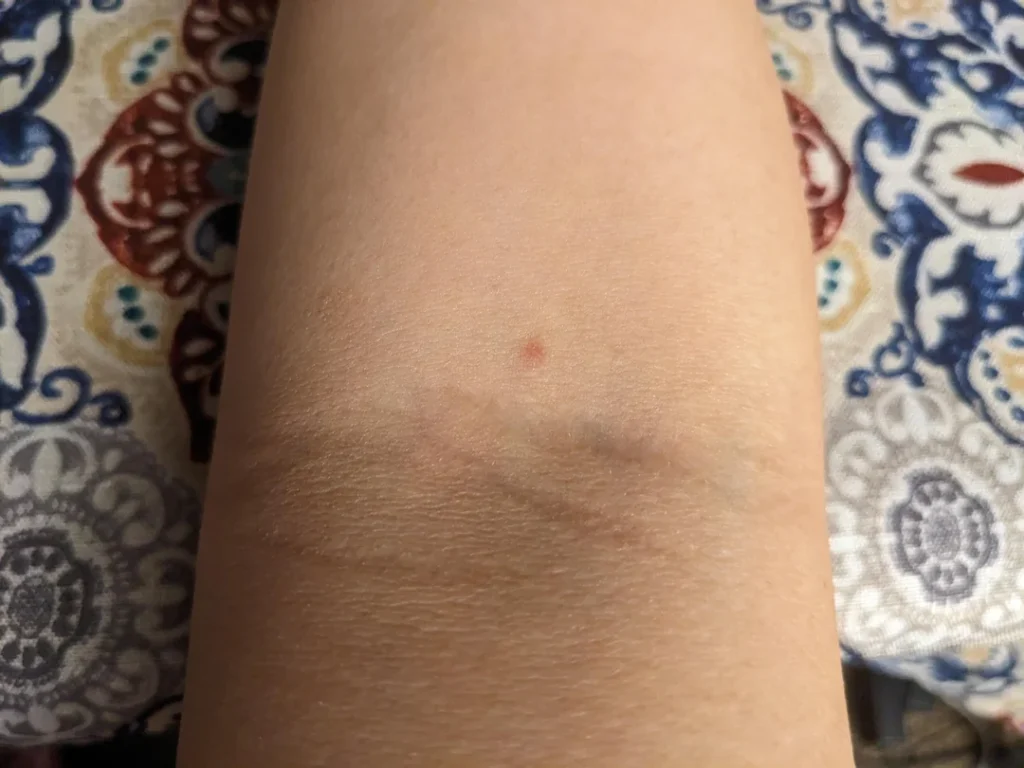- Top Rehab in The State of Tennessee
- 5-Star Reviewed
- Most Major Insurance Accepted
Medically Reviewed by Dr. Michael Ferri
November 15, 2024
Track marks are the scars, discoloration, or visible damage left on the skin from repeated intravenous (IV) drug use. They are typically seen along veins where drugs are injected and can appear as small puncture wounds, scars, or bruises. Over time, frequent injections in the same area can cause the veins to collapse, leading to more prominent scarring and damage.
Track marks often appear as small, round puncture scars along the veins. They can also appear as scabs, redness, and discoloration.
Depending on the severity and frequency of drug use, they can also look like:

The medical term for track marks is injection site scars or venipuncture scars.
These terms refer to the physical damage caused by needles piercing the skin and veins.
In severe cases, these scars may also be categorized under conditions such as chronic venous insufficiency or cutaneous abscesses caused by poor injection hygiene.
Track marks can appear on any part of the body with accessible veins.
The most common areas include:
IV drug use poses significant health risks, including:
Track marks are caused by repeated puncturing of the skin and veins with needles during intravenous drug use.
Additional factors contributing to the severity of track marks include:
Any drug administered intravenously can cause track marks.
Common substances that include drug abuse often involve:
In addition to track marks, IV drug use may present the following signs:
Signs someone is using IV drugs may include:
Track marks on hands typically appear as small, dark scars or bruises on the back of the hand. They may also show between the fingers, often accompanied by swelling or skin discoloration.
On the arms, track marks are usually visible along veins in the forearms or around the elbows. They may look like puncture scars, linear discoloration, or areas of hardened skin.
Track marks on legs often appear on the thighs or behind the knees. These marks may be harder to see but can resemble scars, bruises, or infected wounds.
Individuals may attempt to conceal track marks by:
The first step towards healing is to stop injecting substances. Continuing IV drug use can and will cause further skin and vein damage, making it impossible to heal.
While some track marks may fade with time, others can become permanent if not properly treated. Addressing track marks involves improving your skin, and adopting healthy practices.
Minor track marks may fade with time, but severe scarring can be permanent and depends on the severity of the damage.
This can include:
Harm reduction practices, such as using clean needles and rotating injection sites, may help minimize track marks, but the best way to avoid them is to abstain from IV drug use.
Other harm-reduction techniques can include:
Applying ice to reduce swelling and arnica cream to minimize bruising can help to reduce bruises from needles. In addition, keeping the area clean is essential to prevent infection.
You can also reduce bruising with the following:
Abscesses require immediate medical attention. Drainage and antibiotics are often necessary to prevent the infection from spreading.
If you suspect an abscess, do the following:
The best treatment for IV drug addiction combines:
Track marks may fade with time and proper care, but they also serve as a visible reminder of the risks of IV drug use.
The best way to heal is to quit using drugs, adopt healthier practices, and seek professional treatment. If you or someone you know is struggling with IV drug use, Music City Detox can help. Call us now at 615-695-1009 or verify your insurance today.